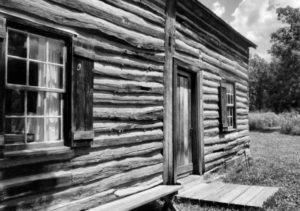
Front entrance, Faribault cabin. Image courtesy of Timothy Burbank.
It occurred to me, as I talked with visitors during our recent gig at The Landing, that context is hugely important in delivering effective interpretation.
But for that event, and for most any living history event we do, there are layers upon layers of context, a variety of circumstances and facts that surround the event. I’m embarrassed to say I missed a layer or two in my preparation for this event . . .
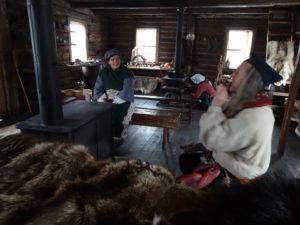
Cozy interior, Faribault cabin, Folkways of the Holidays, 2015. Image courtesy of Pat Ciernia.
There is, of course, the context of specific time and immediate location: in this case, a cabin built by, or for, Oliver Faribault about 1845. There is the slightly larger geographic context: the location within both Iowa, and later Minnesota, territories and Dakota homelands, barely a mile from the village of Chief Shakopee II and not quite 25 miles from Fort Snelling. Then there is the context of the event: how modern holiday traditions are rooted in the cultural traditions of the ethnic groups who settled in the Minnesota River Valley in the 19th-century. In the Faribault cabin, French Canadian traditions are highlighted.
I was prepared for sharing French Canadian holiday traditions. I was familiar with the history of the cabin itself. I had most of the Faribault family story straight in my head. I was secure in the timeline of treaties, territorial status and statehood. And I know a whole lot (too much some might say!) about trade goods, the English-Ojibwe trade and the North West Company in the early 19th century.
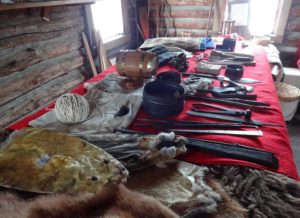
Furs and trade goods on display, Faribault cabin. Image courtesy of Pat Ciernia.
But much to my dismay, I wasn’t prepared for a whole different category of questions . . . especially details of the Dakota trade with American fur companies. Perhaps because of recent commemorations of the US-Dakota War of 1862 or reports across the media about the conflict surrounding the Dakota Access Pipeline in North Dakota, I found myself in conversation with visitors thoughtful and curious about economic and cultural relationships between Americans and Dakota people in the years before and after statehood.
Even before the second trolley arrived, I realized that I simply didn’t know enough about the American-Dakota fur trade. I extrapolated what I could from the English-Ojibwe trade, but mostly changed the subject to topics I felt more comfortable with. I really felt like I was on “thin ice,” and I really felt guilty that I could not offer the quality of interpretation I think the visitors deserved.
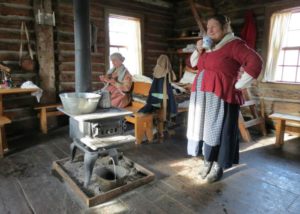
Contemplating the holiday cooking. Image courtesy of Timothy Burbank.
So, after two very long days of talking about how to make a proper French Canadian tourtiére and the differences between muskrat and beaver habitat, I put out a call for help. What could I read to get me better prepared about the American fur trade with the Dakota? And I got great suggestions . . . what a great group we are!
So, here’s my new year’s reading list, complete with recommendations and notes (in italics) from SpenceJ. Next month, I’ll share LindaB’s helpful “tidbit” summaries about the differences between British-Ojibwe trade and American-Dakota trade. Thanks guys!
Chardon’s Journal at Fort Clark, 1834-1839. F. A Chardon, Annie Heloise Abel, editor. (University of Nebraska Press, 1997)
I like diaries, journals and descriptions of daily activities like this one. Its 1830s-fur trade, American Fur Company on the Upper Missouri, but that’s not too much of a stretch to Fort Snelling. Fort Clark was at one time a Columbia Fur Company post.
The Dakota or Sioux in Minnesota As They Were in 1834. Samuel W. Pond (Minnesota Historical Society Press, 1986)
Another reminiscence, but showing a picture of Dakota culture in our area in the 1830s. Very detailed. I like it and have given copies to many friends.
Henry Hastings Sibley: Divided Heart. Rhoda R. Gilman (Minnesota Historical Society Press, 2004)
Sibley left all his papers to the Society and Gilman makes excellent use of them. She writes in a very forceful style and her book should remain the definitive biography of Sibley for years to come. Highly recommended.
Recollections of Philander Prescott, Frontiersman of the Old Northwest, 1819-1862. Philander Prescott, Donald Dean Parker, editor (University of Nebraska Press, 1966)
Hard to find, but I’ve found several copies on used book sites. It’s a reminiscence, but specific to Fort Snelling, time and place. It’s a good one.
Red River Trails: Oxcart Routes Between St Paul and the Selkirk Settlement 1820-1870. Rhoda Gilman, Carolyn Gilman and Deborah M. Stultz (Minnesota Historical Society Press, 1979)
The first chapter is all about the Columbia Fur Company in the 1820s and its pretty good. I like the rest of the book too!! Good overview on Minnesota territorial history and commerce.
What this Awl Means: Feminist Archaeology at a Wahpeton Dakota Village. Janet Spector (Minnesota Historical Society Press, 1993)
It has been criticized as a study, but I like it. All about a specific awl found at the Little Rapids site on the Minnesota River. An easy read, it “personalizes” women’s roles using storytelling and archaeology.
PS: I also found a website built by the Minnesota Historical Society about the US-Dakota War of 1862 to have excellent resources, stories and background materials. The site is a resource for learning about the war, its causes, and its far reaching consequences. Highly recommended.

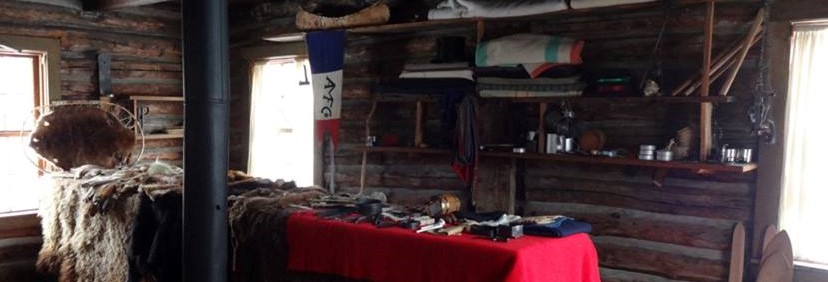
Thank you. Some good suggestions for reading. I would also suggest Northern Slave, Black Dakota: The Life and Times of Joseph Godfrey by Walt Bachman. Joseph was a slave who lived, worked, and escaped from the Faribault Trading Post. It is an important book, and an important part of American and African American history.
Thanks David, for your suggestion. I think we’ll have to add this book to our library and reading lists. Although Godfrey’s story is a little later than we usually interpret in our club activities, more background is always better in interpreting the early 19th century fur trade.
This “spencer” must be a well read historian!
I’d like to meet him sometime
He is indeed! An inspiration to us all!